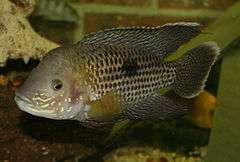Green terror
| Green terror | |
|---|---|
 | |
| male | |
| Scientific classification | |
| Kingdom: | Animalia |
| Phylum: | Chordata |
| Class: | Actinopterygii |
| Order: | Perciformes |
| Family: | Cichlidae |
| Subfamily: | Cichlasomatinae |
| Genus: | Andinoacara |
| Species: | A. rivulatus |
| Binomial name | |
| Andinoacara rivulatus (Günther, 1860) | |
| Synonyms | |
| |
The gold saum (Andinoacara rivulatus, syn. Aequidens rivulatus) is a colorful freshwater fish in the cichlid family.[1] The fish originates from the Pacific side of South America in the coastal waters from the Tumbes River in Peru to the Esmeraldas River in Ecuador. Males and females may reach lengths of 30 cm (12 in). Females are sexually mature at around 12 cm (4.7 in).
As the name implies, late juvenile-phase and adult-phase specimens can be very aggressive. This is not guaranteed, however, and peaceful individuals can be observed. Juveniles of A. rivulatus are often sold in aquarium stores. This species is not to be confused with the blue acara, Andinoacara pulcher, which is similar in appearance; the blue acara is not as aggressive and does not grow as large as the gold saum.
The fish is somewhat deep-bodied, possessing a prominent forehead. Adult males develop a pronounced forehead hump, composed of fatty tissue. Juveniles are tan colored with silver-blue flecks and lack the bright iridescent blue, green, and orange coloration and long, flowing fins of adult specimens.
In nature, A. rivulatus lives in a tropical climate and prefers water with a 6.5–8.0 pH, a water hardness of 25.0 dGH, and a temperature range of 20–24 °C (68–75 °F).
In the aquarium hobby
A. rivulatus is a popular fish in the aquarium trade and is noted for its hardiness, as well as its aesthetic appeal. These characteristics make it ideal for beginning aquarists or for enthusiasts who prefer to avoid managing the strict water parameters required for other fish species. They are ambitious eaters, and do well on a variety of foods including cichlid pellets, flakes, bloodworms, and shrimp. [2]
Size potential and factors influencing growth
A. rivulatus may grow up to 30 cm (12 in) in length; however, 6– to 8-in lengths are more typical. Factors influencing maximum size attainment can be size of the aqaurium relative to population density or the size of the tank relative to the maximum size potential of the fish, water condition and availability of food.
Breeding and assimilation of offspring
A. rivulatus can be successfully bred around 8 cm (3.1 in). Reproduction can be incited by isolating a breeding pair (each from distinct lineages), raising the water temperature to around 80°F, and providing a flat, textured surface (such as a flat rock or pottery fragment) on which the female can deposit her eggs. Upon reaching 3–4 inches in length, A. rivulatus may be integrated into aquariums with larger cichlids. A significant size disparity between newly added fish and existing fish can retard optimum growth rates of the still-maturing fish. Larger fish, particularly A. ocellatus (oscar cichlid) may feed so aggressively that smaller fish may be unable to ingest adequate quantities of food.
Compatibility with other cichlid species
The inherent aggressiveness of A. rivulatus makes them ideal for aquarists who wish to add variety to their cichlid aquarium. With the exception of fully mature P. dovii (wolf cichlid) and P. managuense (jaguar cichlid), which rarely cohabit peacefully, A. rivulatus is cunning enough to survive—and even thrive—with larger cichlids. However, as a rule, a preying cichlid is capable of consuming any animal whose dimensions are inferior to that of the cichlid's fully expanded jaw. A. rivulatus of an appropriate size can often be assimilated with A. ocellatus (oscar cichlid), R. octofasciata (Jack Dempsey cichlid), A. citrinellus (midas cichlid), T. meeki (firemouth cichlid), flowerhorns (no scientific designation), smaller P. managuense (jaquar cichlid) and P. dovii (wolf cichlid), and other similarly aggressive cichlids.
Role in hormone research
A. rivulatus has also been used as a model for the effects of testosterone on lateralization.[3][4]
See also
References
- "Aequidens rivulatus". Integrated Taxonomic Information System. Retrieved June 22, 2005.
- Green terror on FishBase
- ↑ Froese, Rainer and Pauly, Daniel, eds. (2014). "Andinoacara rivulatus" in FishBase. May 2014 version.
- ↑ http://www.aquariumslife.com/freshwater-fish/american-cichlid/green-terror-aequidens-rivulatus
- ↑ Schaafsma, Sara M.; Ton G. G. Groothuis (January 2011). "Sex-specific effects of postnatal testosterone on lateralization in cichlid fish". Animal Behaviour. 81 (1): 283–288. doi:10.1016/j.anbehav.2010.10.019. Retrieved 23 February 2013.
- ↑ Schaafsma, Sara M.; Ton G. G. Groothuis (February 2012). "Sex-specific effects of maternal testosterone on lateralization in a cichlid fish". Animal Behaviour. 83 (2): 437–443. doi:10.1016/j.anbehav.2011.11.015. Retrieved 23 February 2013.